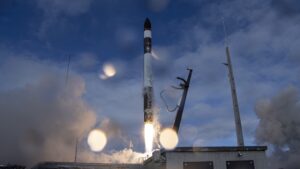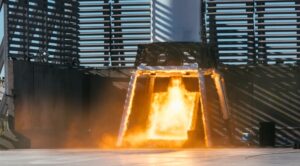Uzbekistan woos Starlink, OneWeb to bring satellite broadband
Tuesday, 17 May 2022 12:38
The overtures to Starlink and OneWeb are part of the Uzbek government’s efforts to strengthen the Central Asian nation’s information technology competitiveness and provide better communications services to underserved remote areas.
The post Uzbekistan woos Starlink, OneWeb to bring satellite broadband appeared first on SpaceNews.
Dawn Aerospace wins Blue Canyon's X-SAT Saturn-Class propulsion business
Tuesday, 17 May 2022 09:13 Dawn Aerospace, a Netherlands-, New Zealand-and U.S.-based space transportation company, has been selected by Blue Canyon Technologies to provide turnkey chemical propulsion systems for the X-SAT Saturn satellite bus. Dawn will supply thrusters, tanks, control electronics, and full-service support in logistics and propellant loading for the ESPA Grande-class satellite.
Blue Canyon Technolo
Dawn Aerospace, a Netherlands-, New Zealand-and U.S.-based space transportation company, has been selected by Blue Canyon Technologies to provide turnkey chemical propulsion systems for the X-SAT Saturn satellite bus. Dawn will supply thrusters, tanks, control electronics, and full-service support in logistics and propellant loading for the ESPA Grande-class satellite.
Blue Canyon Technolo ISRO tests large human rated solid rocket booster for the Gaganyaan program
Tuesday, 17 May 2022 09:13 ISRO successfully completed the static test of a human-rated solid rocket booster (HS200) for the Gaganyaan Program at Satish Dhawan Space Centre (SDSC), Sriharikota, Andhra Pradesh on May 13, 2022, at 7:20 AM local time. HS200 rocket booster is the human-rated version of the well-proven S200 rocket booster of GSLV Mk III satellite launch vehicle, popularly known as LVM3.
The successful co
ISRO successfully completed the static test of a human-rated solid rocket booster (HS200) for the Gaganyaan Program at Satish Dhawan Space Centre (SDSC), Sriharikota, Andhra Pradesh on May 13, 2022, at 7:20 AM local time. HS200 rocket booster is the human-rated version of the well-proven S200 rocket booster of GSLV Mk III satellite launch vehicle, popularly known as LVM3.
The successful co What you need to know about NASA's Boeing Orbital Flight Test-2
Tuesday, 17 May 2022 09:13 NASA and Boeing are taking another major step on the path to?regular?human spaceflight to the International Space Station using American rockets to launch spacecraft from American soil with the second uncrewed test flight of a commercial crew spacecraft.
NASA's Boeing Orbital Flight Test-2 (OFT-2) is targeting launch of the CST-100 Starliner spacecraft on a United Launch Alliance Atlas V r
NASA and Boeing are taking another major step on the path to?regular?human spaceflight to the International Space Station using American rockets to launch spacecraft from American soil with the second uncrewed test flight of a commercial crew spacecraft.
NASA's Boeing Orbital Flight Test-2 (OFT-2) is targeting launch of the CST-100 Starliner spacecraft on a United Launch Alliance Atlas V r Could people breathe the air on Mars
Tuesday, 17 May 2022 09:13 Let's suppose you were an astronaut who just landed on the planet Mars. What would you need to survive?
For starters, here's a short list: Water, food, shelter - and oxygen.
Oxygen is in the air we breathe here on Earth. Plants and some kinds of bacteria provide it for us.
But oxygen is not the only gas in the Earth's atmosphere. It's not even the most abundant. In fact, only 2
Let's suppose you were an astronaut who just landed on the planet Mars. What would you need to survive?
For starters, here's a short list: Water, food, shelter - and oxygen.
Oxygen is in the air we breathe here on Earth. Plants and some kinds of bacteria provide it for us.
But oxygen is not the only gas in the Earth's atmosphere. It's not even the most abundant. In fact, only 2 Momentus "Go for Launch" for First Vigoride Mission
Tuesday, 17 May 2022 09:13 Momentus Inc. (NASDAQ: MNTS), a U.S. commercial space company that plans to offer transportation and other in-space infrastructure services, has announced that it has completed the integration of its Vigoride Orbital Transfer Vehicle and customer payloads on the SpaceX Falcon 9 launch vehicle that will be used for the Transporter-5 mission targeted for launch this month.
Momentus recently
Momentus Inc. (NASDAQ: MNTS), a U.S. commercial space company that plans to offer transportation and other in-space infrastructure services, has announced that it has completed the integration of its Vigoride Orbital Transfer Vehicle and customer payloads on the SpaceX Falcon 9 launch vehicle that will be used for the Transporter-5 mission targeted for launch this month.
Momentus recently EUSPA celebrates its first 365 days of new Galileo operations
Tuesday, 17 May 2022 09:13 The EU Agency for the Space Program celebrates its first anniversary with new services, a new satellite and even more end users.
Time flies when you're busy getting things done. And in the first year of its existence, the EU Agency for the Space Program (EUSPA) has gotten a lot of things done.
"EUSPA's launch one year ago today represented the start of a new era for the EU Space Prog
The EU Agency for the Space Program celebrates its first anniversary with new services, a new satellite and even more end users.
Time flies when you're busy getting things done. And in the first year of its existence, the EU Agency for the Space Program (EUSPA) has gotten a lot of things done.
"EUSPA's launch one year ago today represented the start of a new era for the EU Space Prog Next Stop: Hawksbill Gap
Tuesday, 17 May 2022 09:13 Perseverance was on the move this past week after finishing up remote science activities at Enchanted Lake, an exposure of finely layered rocks that may represent some of the lowest deposits of the delta. The rover threaded its way east around large sandy dune ripples before heading north enroute to Hawksbill Gap, where the team hopes to collect our first set of delta samples and eventually asce
Perseverance was on the move this past week after finishing up remote science activities at Enchanted Lake, an exposure of finely layered rocks that may represent some of the lowest deposits of the delta. The rover threaded its way east around large sandy dune ripples before heading north enroute to Hawksbill Gap, where the team hopes to collect our first set of delta samples and eventually asce OneWeb and Telefonica collaborate to extend connectivity across Europe and Latin America
Tuesday, 17 May 2022 09:13 OneWeb, the low Earth orbit satellite communications company, and Telefonica through, Telefonica Global Solutions (TGS), the subsidiary of global telecommunications company Telefonica that manages the international Wholesale, Global Roaming, Multinationals and USA businesses, have signed a Memorandum of Understanding (MoU) to improve connectivity services across Europe and Latin America. The col
OneWeb, the low Earth orbit satellite communications company, and Telefonica through, Telefonica Global Solutions (TGS), the subsidiary of global telecommunications company Telefonica that manages the international Wholesale, Global Roaming, Multinationals and USA businesses, have signed a Memorandum of Understanding (MoU) to improve connectivity services across Europe and Latin America. The col 4D composite printing can improve the wings of drones
Tuesday, 17 May 2022 09:13 The aviation industry faces multiple pressures from higher fuel costs and increased scrutiny over the environmental and quality-of-life impacts from its aircraft. Researchers are looking for new methods of keeping expenses down while improving overall efficiency, and the relatively new market of unmanned aerial vehicles (UAVs) - or drones - is no exception.
UAVs are occupying an ever-growi
The aviation industry faces multiple pressures from higher fuel costs and increased scrutiny over the environmental and quality-of-life impacts from its aircraft. Researchers are looking for new methods of keeping expenses down while improving overall efficiency, and the relatively new market of unmanned aerial vehicles (UAVs) - or drones - is no exception.
UAVs are occupying an ever-growi Landmark partnership between the US and UK to launch new era of spaceflight
Tuesday, 17 May 2022 09:13 Future spaceflight will be made easier and cheaper, following a landmark partnership with the United States to help cut red tape and boost opportunities in the UK, signed by the Transport Secretary this week in Washington.
Transport Secretary Grant Shapps and US Transportation Secretary Pete Buttigieg signed a declaration on 11 May 2022 to work together on future commercial spaceflight mis
Future spaceflight will be made easier and cheaper, following a landmark partnership with the United States to help cut red tape and boost opportunities in the UK, signed by the Transport Secretary this week in Washington.
Transport Secretary Grant Shapps and US Transportation Secretary Pete Buttigieg signed a declaration on 11 May 2022 to work together on future commercial spaceflight mis Gilmour Space completes full duration test fire of new Phoenix rocket engine
Tuesday, 17 May 2022 09:13 An Australian launch services company known for its orbital-class hybrid rocket technology, Gilmour Space Technologies, has unveiled a new 3D printed liquid rocket engine that will power the third stage of its Eris rocket to orbit.
The company has shared a video of a successful 190-second Mission Duty Cycle (or mission duration) test fire of its new regeneratively-cooled liquid rocket engi
An Australian launch services company known for its orbital-class hybrid rocket technology, Gilmour Space Technologies, has unveiled a new 3D printed liquid rocket engine that will power the third stage of its Eris rocket to orbit.
The company has shared a video of a successful 190-second Mission Duty Cycle (or mission duration) test fire of its new regeneratively-cooled liquid rocket engi Inmarsat welcomes Netherlands 3.5ghz Advisory Committee report
Tuesday, 17 May 2022 09:13 Commenting on the report to the Dutch Ministry of Economic Affairs and Climate from the Advisory Committee on 3.5GHz Communications Jason Smith, Inmarsat Chief Operating Officer, said: "Inmarsat is pleased to read the recommendations from the Advisory Committee to the Ministry on the National Frequency Plan and the focus on the necessary protection of essential safety services provided via satel
Commenting on the report to the Dutch Ministry of Economic Affairs and Climate from the Advisory Committee on 3.5GHz Communications Jason Smith, Inmarsat Chief Operating Officer, said: "Inmarsat is pleased to read the recommendations from the Advisory Committee to the Ministry on the National Frequency Plan and the focus on the necessary protection of essential safety services provided via satel Space systems dominate Rocket Lab revenue
Tuesday, 17 May 2022 08:57
Rocket Lab, the company best known for its Electron small launch vehicle, generated most of its first quarter revenue from other space systems and not launch itself.
The post Space systems dominate Rocket Lab revenue appeared first on SpaceNews.
ABL Space Systems completes acceptance testing of RS1 upper stage
Tuesday, 17 May 2022 07:34
ABL Space Systems has completed testing of the second stage of its small launch vehicle, four months after a previous version of the stage was destroyed in a test accident.

